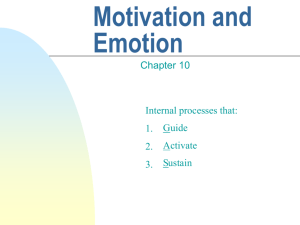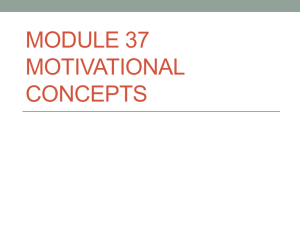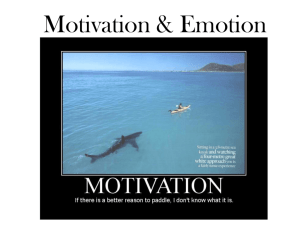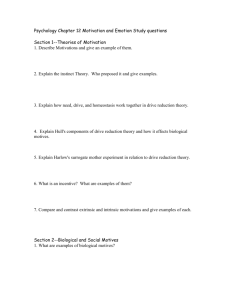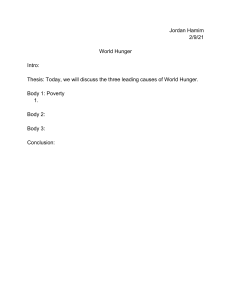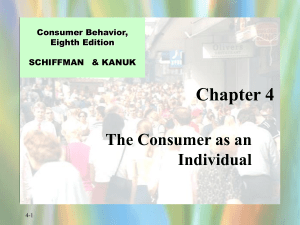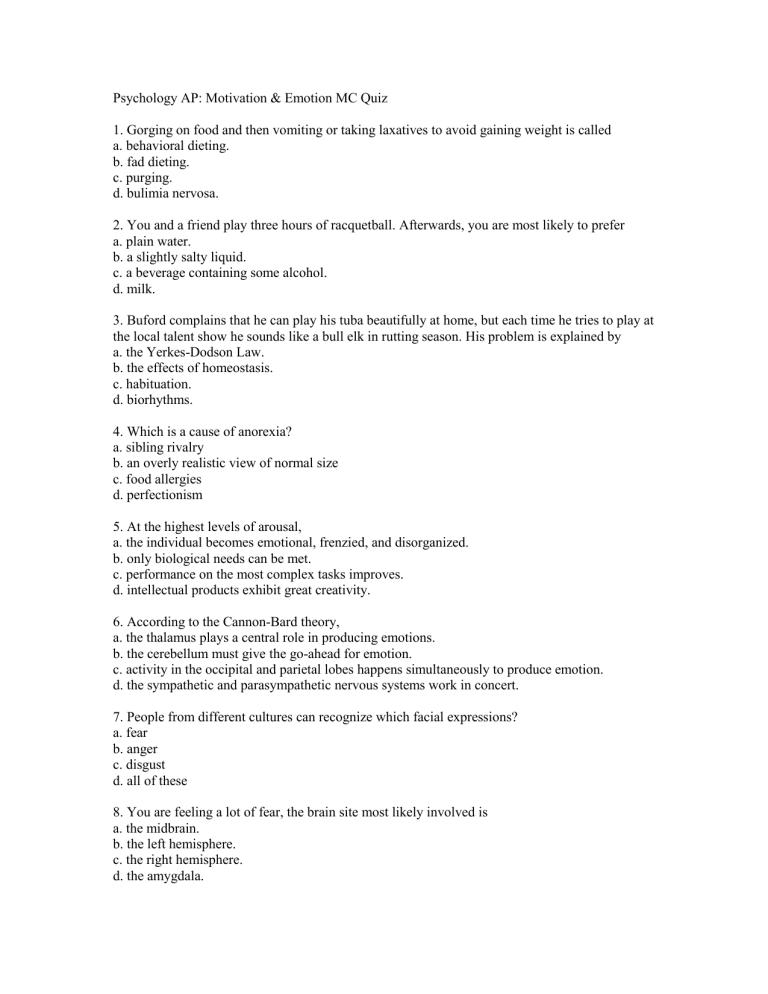
Psychology AP: Motivation & Emotion MC Quiz 1. Gorging on food and then vomiting or taking laxatives to avoid gaining weight is called a. behavioral dieting. b. fad dieting. c. purging. d. bulimia nervosa. 2. You and a friend play three hours of racquetball. Afterwards, you are most likely to prefer a. plain water. b. a slightly salty liquid. c. a beverage containing some alcohol. d. milk. 3. Buford complains that he can play his tuba beautifully at home, but each time he tries to play at the local talent show he sounds like a bull elk in rutting season. His problem is explained by a. the Yerkes-Dodson Law. b. the effects of homeostasis. c. habituation. d. biorhythms. 4. Which is a cause of anorexia? a. sibling rivalry b. an overly realistic view of normal size c. food allergies d. perfectionism 5. At the highest levels of arousal, a. the individual becomes emotional, frenzied, and disorganized. b. only biological needs can be met. c. performance on the most complex tasks improves. d. intellectual products exhibit great creativity. 6. According to the Cannon-Bard theory, a. the thalamus plays a central role in producing emotions. b. the cerebellum must give the go-ahead for emotion. c. activity in the occipital and parietal lobes happens simultaneously to produce emotion. d. the sympathetic and parasympathetic nervous systems work in concert. 7. People from different cultures can recognize which facial expressions? a. fear b. anger c. disgust d. all of these 8. You are feeling a lot of fear, the brain site most likely involved is a. the midbrain. b. the left hemisphere. c. the right hemisphere. d. the amygdala. 9. If the lateral hypothalamus is destroyed, a rat will a. drink more water than biologically needed. b. refuse to drink until forced to do so. c. eat until it becomes obese. d. refuse to eat until force fed. 10. Cutting sensory nerves from the stomach, or removing it entirely, causes a. a total loss of appetite. b. eating based on recognized need, not internal feelings of hunger. c. some changes in eating, but hunger still occurs. d. the need for patients to be "trained" to eat; otherwise, they would inadvertently starve to death. 11. Which is TRUE regarding the influence of cultural values on eating behaviors? a. They are the primary cause of innate taste aversion. b. They greatly affect the incentive value of various foods. c. They determine a person's set point for various foods. d. They have a homeostatic influence on amount of food consumed. 12. Kinesics refers to the study of a. body language. b. emotional expression. c. ANS arousal during emotional states. d. emotional expression in animals and humans. 13. Stimulus motives are a. needs that are learned, such as the needs for power or for achievement. b. innate but not necessary for survival. c. not innate but necessary for survival. d. innate and necessary for survival. 14. The polygraph or "lie detector" primarily measures which component of emotion? a. attribution b. emotional expression c. physiological arousal d. vocal modulation 15. If the ventromedial hypothalamus is destroyed, a rat will a. eat until it becomes obese. b. refuse to eat until forced to do so. c. drink excessively. d. refuse to drink until forced to do so. 16. The chief antidote for test anxiety is a. overpreparation. b. thought suppression. c. regression. d. discussing the problem with your professor. 17. Taste aversions are a type of classical conditioning, and if there is a long delay between the CS and US, conditioning is usually prevented. The fact that people and animals can develop taste aversions even though sickness occurs long after eating indicates that a. taste aversions are really more like operant conditioning. b. taste aversions can be unlearned as well. c. there is a biological tendency to associate sickness with any food eaten earlier. d. there is less aversion associated with the actual sickness than with whatever caused the sickness in the first place. 18. The most universally recognized facial expression is a. pursed lips. b. smiling. c. sticking out your tongue. d. raising your eyebrows. 19. Intrinsic motivation occurs when a. obligations or approval are factors. b. there is no obvious external reward for one's behavior. c. there are obvious external factors controlling behavior. d. extrinsic motivation is also high. 20. A competitive diver approaches the end of the board with rapidly beating heart and a dry mouth, a result of increased a. adrenaline. b. amines. c. cortisone. d. endorphins. 21. If a food causes sickness, or simply precedes sickness caused by something else, a learned __________ may result. a. psychosomatic illness b. taste aversion c. anorexia d. specific hunger 22. The hypothalamus has __________ hunger center(s). a. no control over b. total control over c. the most direct control over d. one 23. When a polygraph operator asks a subject, "Have you ever lied to your parents?" he or she is using a. a control question. b. a critical question. c. deception. d. an irrelevant question. 24. A person got very sick after eating a cheese danish. It is likely that the person will a. eventually eat another cheese danish. b. eat another kind of danish. c. never eat another cheese danish. d. only eat cheese danishs from now on. 25. Which of the following is the correct sequence for the motivational process? a. reinforcement - need - behavioral response b. need - drive - behavioral response c. drive - behavioral response - need d. behavioral response - drive - need 26. Push is to pull as __________ is to __________. a. goal; need b. response; need c. episodic; cyclic d. need; goal 27. The most critical physiological factor controlling hunger is the a. level of blood sugar. b. presence of stomach contractions. c. taste of food. d. presence of weakness or fatigue. 28. Researchers are certain that facial expressions of __________ are recognized by people of all cultures, but they are not so certain that facial expressions of __________ are universal. a. fear; interest b. sadness; surprise c. anger; contempt d. disgust; horror 29. The maintenance of steady states of temperature and blood pressure are examples of a. thermostasis. b. homeostasis. c. intrinsic motivation. d. biological rhythm. 30. The employees at a factory were excellent workers until a week before Christmas when a rumor spread that economic conditions would force the plant to close in four days. The quality and quantity of work took a down turn as the workers spent time discussing among themselves the plausibility of the rumor and what they would do if it were true. Maslow would say that these workers were motivated by a. meta-needs. b. intrinsic motivation. c. esteem and self-esteem. d. safety and security. 31. Unlearned biological motives necessary for survival are termed a. primary motives. b. secondary motives. c. drives. d. stimulus motives. 32. Which theory of emotion holds the view that bodily changes PRECEDE emotion and that we experience an emotion AFTER our body reacts? a. the common sense theory b. the Cannon-Bard theory c. attribution theory d. the James-Lange theory 33. Sensory distortions and disturbed thinking reported by people who have undergone sensory deprivation support the __________ theory of motivation. a. drive reduction b. arousal c. episodic d. opponent-process 34. In hunger, a set point is a. similar to a body's thermostat for blood sugar. b. the weight you maintain when you attempt to diet. c. related to the proportion of body fat your body normally maintains. d. determined by adult eating habits. 35. The polygraph's most common error is to (VOID) a. fail to detect persons who can lie without anxiety. b. fail to detect persons who are guilty. c. identify as guilty persons who are innocent. d. identify as innocent persons who are easily aroused. 36. Which of the following is a secondary motive? a. curiosity b. the desire for money c. physical contact d. thirst 37. What is the correct order of needs in Maslow's hierarchy? a. physiological; esteem; safety; self-actualization; love and belonging b. self-actualization; physiological; safety; love and belonging; esteem c. physiological; safety; love and belonging; esteem; self-actualization d. self-actualization; safety; love and belonging; esteem; physiological 38. Stimulus motives differ from primary motives in that they a. are unlearned and necessary for survival. b. appear to be innate, but are not necessary for survival. c. are acquired through various forms of conditioning and learning. d. include needs for security, status, approval, and achievement. 39. Motivation is the process of initiating, __________, and directing activities of the organism a. supplying b. sustaining c. surveying d. suspending 40. According to Maslow's theory, the basic needs include a. physiological needs, safety, and security. b. safety, love, and belonging. c. physiological needs and belonging. d. security and esteem. 41. In both males and females, pupil size is related to a. attractiveness to others. b. perceived intelligence. c. perceived locus of control. d. desirability as a leader. 42. The question, "Is your address (person's address)?" asked during the administration of a lie detector test, is a(n) __________ question. a. control b. critical c. relevant d. irrelevant 43. Which theory holds that we are afraid because we run or are angry because we strike? a. attribution b. James-Lange c. Cannon-Bard d. cognitive 44. People who have had their stomachs surgically removed a. report they still have hunger pangs. b. may fail to eat regularly. c. must be force fed. d. still experience hunger. 45. At the top of Maslow's hierarchy of motives are a. love and belonging. b. esteem and self-esteem. c. self-actualization. d. safety and security. 46. If you saw George with his pupils dilated (enlarged), you would most likely assume that he was a. angry. b. disgusted. c. happy. d. scared. 47. If an overweight adult was overfed as a child, as an adult he or she will have __________ fat cells. a. larger b. more and larger c. more d. the same number of 48. Which of the following statements about the sex drive is TRUE? a. The sex drive is greatly affected by hormone levels in humans. b. The sex drive is necessary for individual survival. c. The sex drive is homeostatic. d. The influence of hormones decreases as we ascend the biological scale. 49. Moods a. are the most extreme forms of various emotions. b. are subtle emotional undercurrents. c. reflect base physiological changes. d. reflect only positive emotions. 50. After an animal is allowed to copulate until it has no further interest, it will resume sexual activity when a new partner is provided. This is called a. a stimulus need. b. a curiosity drive. c. the Coolidge effect. d. an episodic drive. 51. You are feeling happy and sad at the same time. Research into brain activity would indicate that processing is primarily occurring in a. the midbrain. b. the left hemisphere. c. the right hemisphere. d. both hemispheres. 52. Which theory claims that emotions are organized in the brain and that emotional feelings and bodily expressions occur simultaneously? a. the common sense theory b. the Cannon-Bard theory c. attribution theory d. the James-Lange theory 53. In an early experiment by Cannon and Washburn, Washburn swallowed a balloon so that they could measure hunger. Their conclusion was that a. the balloon prevented hunger by filling up the stomach. b. the balloon recorded hunger pangs or contractions. c. the balloon stopped digestion, and so nothing could be said of normal hunger. d. hunger had nothing to do with stomach contractions. 54. The satiety system is to the feeding system as the __________ hypothalamus is to the __________ hypothalamus. a. ventromedial; lateral b. lateral; ventromedial c. nonhomeostatic; homeostatic d. cyclic; episodic 55. If your body is dehydrated, but you are not thirsty, we would say that you have a. a drive but not a need. b. a need but not a drive. c. both a drive and a need. d. neither a need nor a drive. 56. Which of the following can alter the body's set point? a. over feeding in childhood b. external eating cues c. severe dieting d. low self-esteem 57. A part of the nervous system that prepares the body for emergencies is the __________ division. a. parasympathetic b. sympathetic c. somatic d. adaptive 58. A circadian rhythm refers to a cycle a. of sexual receptivity caused by hormone cycles. b. of bodily activity approximately 24 hours in length. c. of emotional arousal. d. during which various bodily systems are in phase. 59. Unlike other drives, pain is characterized by a. avoidance rather than positive goal-seeking. b. cyclical occurrences. c. freedom from the influence of learning. d. a strong link to estrogen levels in the body. 60. Which of the following is a characteristic of bulimia nervosa? a. Vomiting, laxatives, or diuretics are used to lose weight. b. There are repeated attempts to lose weight by severe dieting. c. It occurs equally in males and females. d. It is an adolescent growth phase that a few women go through and later disappears. 61. The __________ describes the relationship between arousal level, task difficulty, and efficiency of performance. a. arousal theory b. drive reduction theory c. Yerkes-Dodson Law d. inverted-U function 62. Which of the following is an assumption of arousal theory? a. Zero level of arousal is the most desirable. b. High levels of arousal are the most desirable. c. Optimal levels of arousal exist for each person. d. Optimal levels of arousal exist for various activities. 63. Secondary motives are a. needs that are learned, such as the needs for power or for achievement. b. innate but not necessary for survival. c. not innate but necessary for survival. d. innate and necessary for survival. 64. Which of the following is a primary motive? a. curiosity b. the desire for money c. physical contact d. thirst 65. Electrically stimulating the lateral hypothalamus will cause a rat to a. start eating. b. stop eating. c. start drinking. d. stop drinking. 66. The part of the autonomic nervous system responsible for restoring the body and conserving energy is the a. somatic nervous system. b. limbic system. c. parasympathetic division. d. sympathetic division. 67. The inverted-U function describes the relationship between a. deprivation and sex drive. b. stimulation and curiosity. c. arousal and performance. d. sex drive and satisfiers. 68. The body structure most closely associated with thirst is the a. pancreas. b. pituitary gland. c. hypothalamus. d. limbic system. 69. The most appropriate name for the polygraph is a. lie detector. b. arousal recorder. c. mind reader. d. guilt meter. 70. Extrinsic motivation stems from a. obvious external factors. b. intrinsic motivation. c. primary drives. d. self-actualization. 71. Which of the following statements about the sex drive is TRUE? a. The sex drive in females is closely tied to the menstrual cycle. b. The sex drive in humans is completely liberated from the influence of hormones. c. The sex drive in humans can be aroused at virtually any time by almost anything. d. Recent sexual activity prevents sexual desire from occurring again after a certain amount of time. 72. People with weight problems are more likely to eat when experiencing the emotion of a. anxiety. b. anger. c. sadness. d. any of these 73. The need for achievement a. is greatest for behaviors leading to financial and material success. b. does not occur in primitive cultures. c. is defined as the desire to meet internalized standards of excellence. d. is greater in women than in men. 74. Life-threatening weight loss due to self-inflicted starvation is called a. fasting. b. malnutrition. c. anorexia nervosa. d. hypoglycemia. 75. The question, "Did you rob the liquor store?" asked during the administration of a lie detector test, is a(n) __________ question. a. control b. deceptive c. relevant d. irrelevant 76. Which of the following statements about the sex drive is TRUE? a. Most psychologists believe that sex is a primary motive because it is necessary for individual survival. b. Normal male animals are always ready to mate. c. Normal female animals are always ready to mate. d. The sex drive is considered a primary motive because it is primarily homeostatic in nature.
